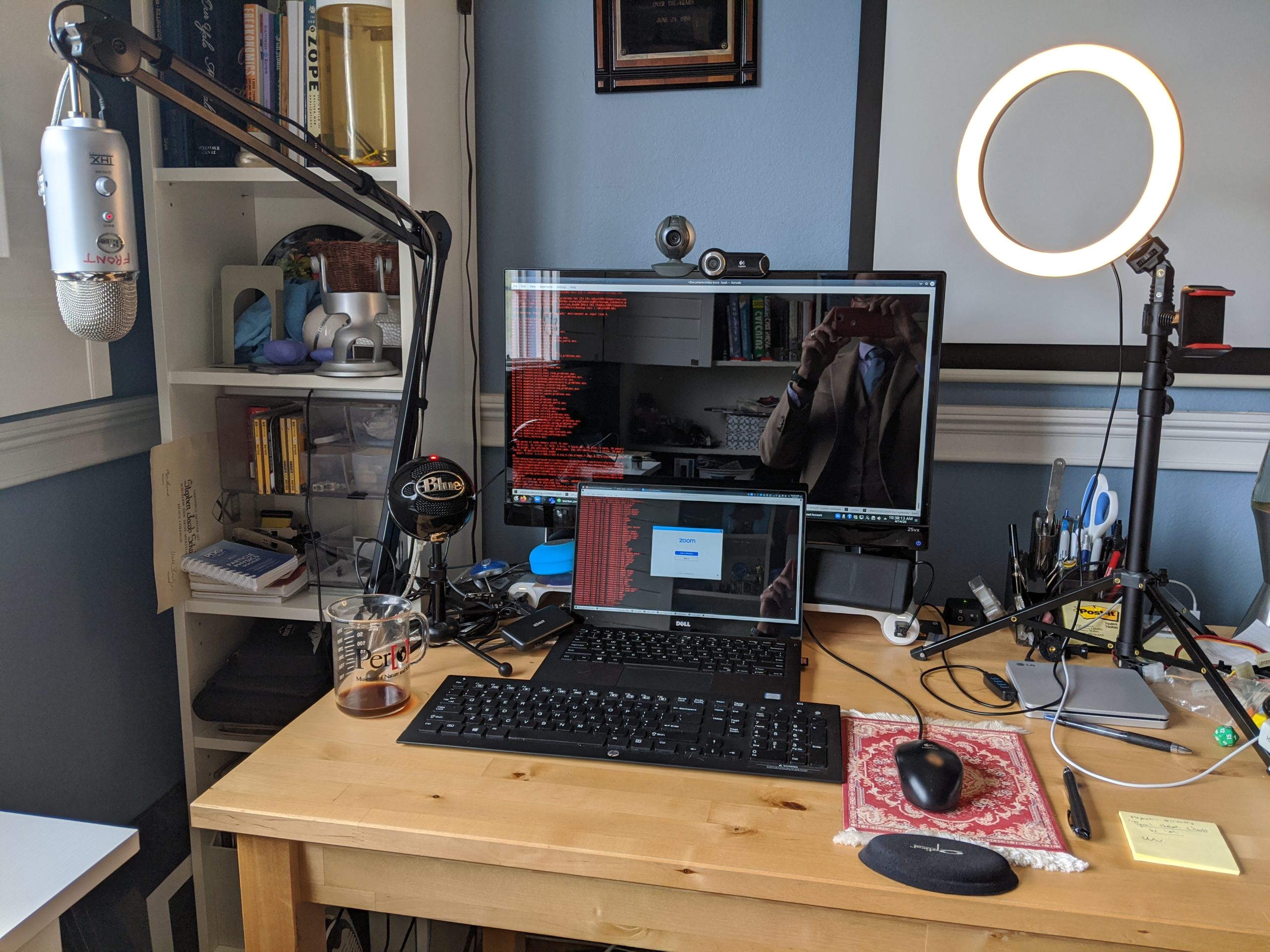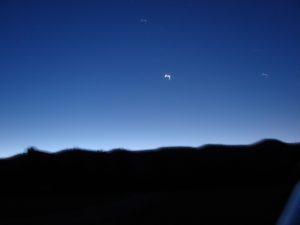
This weekend is drawing to a close. I write this not from Dallas, where Jodi and I finally returned home 2 weeks ago after a brief (and originally unplanned) vacation in Wisconsin, but from the SMU campus in Taos, NM. It is Sunday morning. The past week – the first week of classes for this fall term – was long and painful, brightened by the students I get to work with this fall in class and on research and dimmed by the usual complexities of life in an academic department. I won’t get into the dimming. I’ll focus on the bright spots of the week.
Partial Eclipse in Dallas
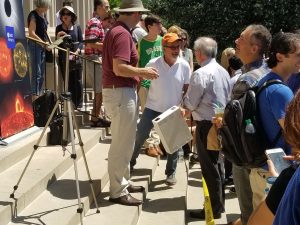
Because this was the first week of classes, there was no way I was going to be able to be in the path of totality of the Great American Eclipse of 2017. Resigned to the fact that my duties as a faculty member would keep me anchored to Dallas, instead I decided to take some initiative in organizing campus activities centered on the eclipse (75% in Dallas) and hosted by the SMU physics department. At first, my plan was just to invite Honors Physics students to join me at the telescope near Heroy Hall for a solar eclipse viewing event. I had planned to make homebrew pinhole-based solar observing equipment and rig my backpack telescope for solar viewing.
But then the buzz of inquiries began. SMU communications inquired as to what we as a department were organizing. The SMU Central Library asked the same, and offered to help advertise our efforts. The problem was that were was no organized effort. I am a particle physicist, not an astronomer. I have taught astronomy and taken up very amateur observing efforts, mostly as an excuse to share my love of stellar astrophysics and astronomy and relativity with an audience (I prefer viewing with a crowd, rather than alone). But I am no astronomer. And while there are astronomers around SMU, nobody seemed to be heeding the unspoken call for an organized event. Fresh back from vacation, I wasn’t exactly ready to jump up and take the lead; I just wanted to share the eclipse with my Honors Physics students.
Then the Dean came knocking. It turned out than an idea was bubbling up in the suites of Dedman College and SMU’s Research Office: to reflect the eclipse as an image into the historic rotunda of Dallas Hall, the oldest building on campus. It’s simple enough. Get a mirror. Tilt it correctly. Make an image of the sun on a wall about 50 feet away. You need to restrict HOW MUCH light you reflect, essentially making a “pinhole mask” over the mirror. This sharpens the image. A big pinhole make a bright blur; a tight pinhole makes a crisp image but sacrifices brightness.
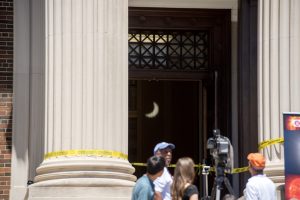
It was a neat idea. I wasn’t convinced that, by the time we masked the mirror with a small enough aperture, we would see anything. But our resident jack-of-all-trades and Astronomy professor, John Cotton, rigged up a mirror holder in his garage, complete with a mounting nut for attaching to a standard camera tripod. The department chair, who enthusiastically took up the call from the Dean, stood with me on the steps of Dallas Hall and tried to make an image in the rotunda. It worked. Brilliantly.
And so instead of sitting quietly with Honors Students and watching the Moon pass in front of the Sun, I found myself pressing to organize our department’s effort to shine the eclipse into Dallas Hall. I made up a banner with the college and department name on it, covered in images of the sun, in 30 minutes; our admin had it off to the printer shortly thereafter. I found myself in the Dean’s suite, talking to staff so they could walk me through the plans to hang a screen and to show me their own banner (“Nobody eclipses Dedman students.” Hell, yes.). What was originally a bunch of unadvertised small-scale efforts in our department had crystallized around this idea, and so a particle physicist found himself being called upon to talk about an eclipse.
And so when the day of the eclipse came, we were ready to share the eclipse safely in Dallas Hall with any student who happened to wander by on their way to class. We expected to maybe entertain a hundred people, mostly students. After all, this was the first day of class. We’ll be lucky if they even make eye contact with us as they wander the campus and Dallas Hall, trying to find their class on discourse and discernment.
I did a 07:10 live 3-minute interview for a local radio station, CBS-affiliate KRLD. I didn’t have a lot of details on the interview; I thought they were recording it for editing and airing later. So when the producer of the segment called me and asked, “Are you ready to go live?” I swallowed my fear and readied myself for their questions.
From my perspective, the interview went fine. I shared why this method of viewing was safe and didn’t need glasses, how anyone could do it at home, and talked about the lack of effects of the eclipse on people (except to maybe make them think it’s the end of the day and it’s time to cut out of work).
I didn’t think much of the effect this interview, or the much wider communication effort SMU had undertaken to advertise the Dedman College and Physics Department event to the community, until people started showing up by the hundreds at Dallas Hall. They arrived in large numbers even 10 minutes before the beginning of the eclipse, which wouldn’t crest for 90 more minutes! People had been calling the physics main office, asking if we had glasses to share during the event (we did not – thus, the mirror).
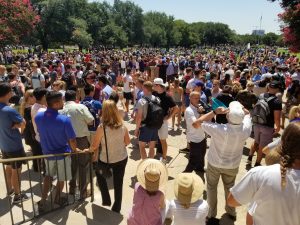
By the time the peak of the eclipse approached, at 1:09pm, thousands of people were milling about on the SMU campus, collecting at Dallas Hall and packing into the rotunda to watch the eclipse projected on a wall. People flocked to telescopes and pinhole devices, marveled at the specks of crescent-shaped light cast by trees on the ground during peak coverage of the sun, and seemed in complete awe of the spectacle. I was told by a colleague that one masters student in economics, so overwhelmed by the magnitude of this event and the simplicity with which one could view it, exclaimed after seeing the eclipse, “How can anyone just go back to their lives after something like this?”
Indeed.
Teaching
I’m teaching 3 small classes this semester. I normally teach one 3-unit course, but instead this fall I am teaching part of a 3-unit course, a 1-unit course, and the 0-unit Honors Physics add-on to the introductory physics sequence. It’s a bit of a blender for me, part of what made me so anxious about this autumn.
One of the classes is a training course for graduate students, primarily within the first 2 years, who are teaching our new cooperative problem-solving sessions for the introductory physics students. Such active-learning problem-solving sessions a brand new to our department, and there was concern that the graduate students – old and new – would not be ready for how different this would be from grading and other duties, or how the undergraduates would react to this new way of conducting part of their intro courses. We started with graduate students just demonstrating their communication skills, and we’ll use the next couple of weeks to collect “lessons learned” from the co-op sessions while looking at some of the data behind active learning and other more modern physics teaching approaches. It’s a light lift for the grads, with a tiny amount of homework. And, it’s just a pilot course to train them. If this works, my goal is to add this course to our catalog and continue to teach it in the future, unless someone else wants to take it over and try it out.
Another course, the more serious of the three, is introductory particle physics, a course I am co-teaching with the department chair and my fellow ATLAS experiment researcher. This is a fun course, taking a wide swim through the subject from the quark model to neutrino mixing, from bubble chambers to solid-state charged particle trackers. Students will have to give presentations near the end of the course, lecturing to us and their peers to teach us all something in which they took a deeper dive. It’s a mix of graduate and undergraduate students, and provides a place where the two populations can mingle and learn from each other while also introducing all the jargon and concepts of the field.
My favorite course, but also the one which gets me no formal credit at all, is Honors Physics. We started with 12 students, but this blossomed to 16 by the end of the add/drop week. I lost none of my original 12 and added 4 new students, so that was pretty exciting. I believe this ties with the previous largest number of students in the course.
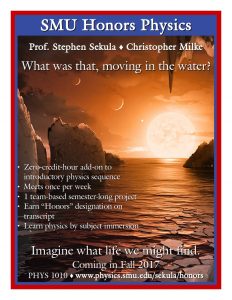
This semester, Honors Physics is themed around a singular project: conceive of, and try to solve three problems in, a robotic mission to one of the rocky, Earth-like planets around the star, Trappist-1. It’s inspired by the “Breakthrough Starshot” initiative, a prize-driven initiative to seek out technologically feasible ideas for sending such a probe mission to the Proxima star system, a mere 4 light-years away. That’s already a hard problem, a journey of about 24 trillion miles. Trappist-1 is almost 40 light-years away, a journey of almost 240 trillion miles. But the payoff of observing its rocky planets could be enormous, and I want to see what students come up with in trying to conceive of such a mission.
This week we’ll get hands on with motion in space and the intermingling of space and time in making even modest and simple measurements. Students will be organized into their mission teams and will have to select a mission commander, mission name, and prepare for the presentation of their first challenge and ideas about solving it on September 19. This is a course based entirely on active group learning. There is almost NO lecture. My teaching assistant and I facilitate exploration of one or more phenomena once per week, and discuss lessons-learned from those experiments. We’ll link them to their mission, but we won’t lecture them on the details. Instead, we believe that facilitating this exploration encourages curiosity, and trial-and-error, and most students will link these efforts to pedagogy they learn in the associated introductory classes.
From this, a deeper understanding of physics and research will emerge normally, the way it does in the graduate research environment. I don’t lecture my graduate students; I help them find interesting problems under the umbrella of a unifying theme (right now, that is Higgs boson interactions with bottom quarks) and encourage them to take up one of those problems as part of their thesis research. That is a much better way to encourage deeper physics learning than endless lecturing, a fact upheld by a large body of data and considered applicable in the structure even of introductory physics courses.
SMU-in-Taos
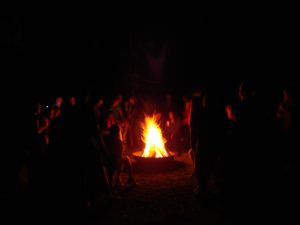
I am in Taos this weekend on a retreat with the Hunt Leadership Scholars, an outstanding group of SMU students with excellence in academics and a passion for leadership and especially community engagement. The fever of the partial eclipse had students still excited about astronomy, so when I setup the telescope kept here on campus and pointed it at Saturn on the first night of the retreat, I had a captive audience of about 20-30 students who walked over from the center of campus to a dark field near the faculty housing and took turns checking out Saturn.
Conversations turned to dark matter and dark energy, the lives and deaths of stars, how to measure distance in the cosmos, and the existence of parallel universes. It was an awesome night. I stayed up to 11:30pm, the latest I’ve stayed up and still felt good about it in a long while.
This morning, I awoke at 4:40am to treat myself to a view of the Orion Nebula, only visible in the early morning this time of year due to our orbital position around the sun. It was stunning. The sky is so dark here, compared to Dallas, that the dome of the earth explodes with a million pinpoints of light. Constellations like Orion stand out like stunning beacons in the sky. The Orion Nebula took me merely moments to spot and track with the telescope, which I am operating manually.
This past week was darkened by meetings and arguments over department matters. But ironically, it was brightened by an eclipse. It was still brightened by students excited by the new semester. It was brightened even further by dark skies over Taos, NM, and the possibility of watching the cosmos slide by in the sky as our Earth continues to turn. I take some comfort in these things. Even when chaos and disorder reign in the realm of human interactions, one can turn back to the cosmos and be reminded there is firmament … of a sort.
Acknowledgements
The eclipse-day photos in the post are all from here: http://blog.smu.edu/research/2017/08/23/total-eclipse-first-day-school/



